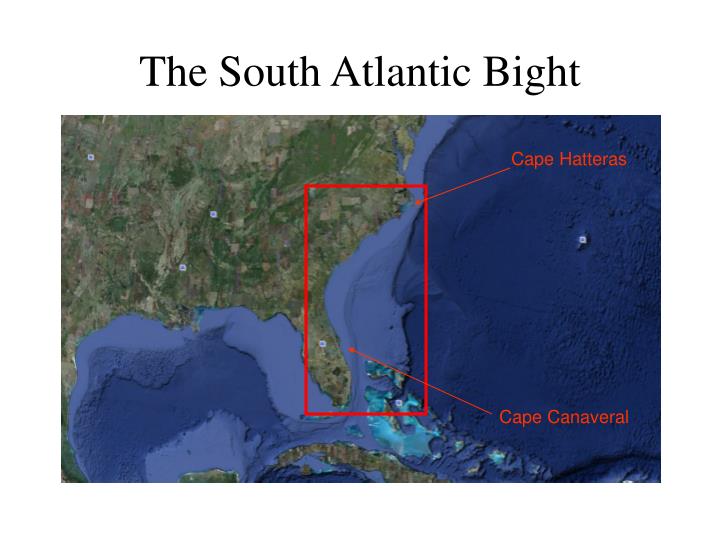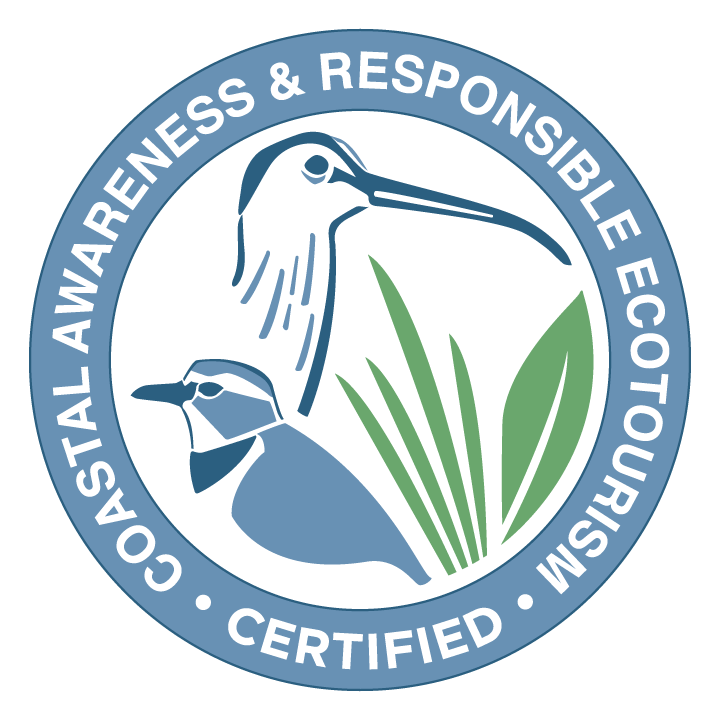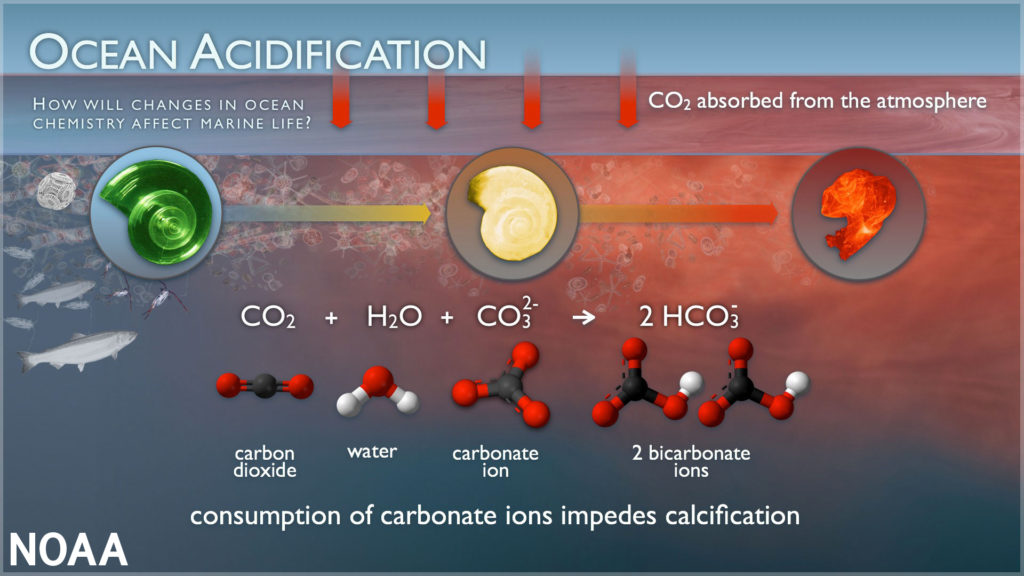Decline of Oyster Populations in Georgia

Key concepts:
- Habitat loss
- Non-point and point source pollution
- Over harvesting
- Disease
- Sea level rise
- Shell shortage
- Ocean acidification
Georgia’s oyster resources were once immense, and supported a thriving cannery-based industry, however overharvesting, habitat loss, pollution and disease have resulted in the reduction of the fishery to a fragmentary status. Coastal development (increasing population growth, wetland loss, increased boat traffic, and increased non-point source pollution (agriculture, homes, sewage treatment, septic tanks, car exhausts, sediment from construction) all result in deteriorating water quality.
Habitat loss
The Eastern Oyster (Crassostrea virginica) is native to the eastern coast of America from St. Lawrence, Canada to the Yucatan Peninsula and the West Indies. In Georgia, Eastern Oysters were once in abundance and heavily fished along the coastal estuaries during the late 1800s and the early 1900s. In 1908, Georgia led the nation in oyster harvesting, primarily for the oyster canning industry.
However, their importance has declined since the 1930s because of overharvesting, and the industry serves only as a supplemental fishery resource today. Since the decline, there have been changes in the total area and decreases in total acreage of reefs, which is due to a variety of factors.
Non-point pollution
Non-point pollution is that which comes from a number of smaller and more dispersed sources. Possible non-point pollutant sources include runoff from urban and agricultural areas, sewage discharges, faulty septic fields, and wildlife areas. Because One of the most prevalent types of non-point pollution comes from improperly damaged, leaking or failing septic systems, resource managers ensure the safety of shellfish harvesting waters and bathing waters by monitoring commercial and recreational shellfish beds regularly for fecal coliform (bacteria found in the gut and feces of warm-blooded animals). Coliform bacteria are members of the Enterobacteriaceae family and are commonly referred to collectively as E. Coli. E. coli are relatively easy to test for and therefore used as indicator bacterium. The presence of this bacterium in the water is a good indication that pathogenic (disease causing) organisms could also be in the water.
Public and commercial shellfish beds are closed by resource managers from the Georgia Department of Natural Resources if E. coli counts exceed recommended levels to protect the oysters and humans. The Georgia Division of Public Health is responsible for closing public bathing areas if fecal coliform levels are too high. Non-point source pollution tends to be the largest contributor of pollutants with regard to shellfish bed closings.
Disease
Recent years of drought have adversely affected the salinity regimes of southern estuarine systems, encouraging the spread of diseases including the protozoan pathogens which cause Dermo and MSX. While these diseases are not harmful to humans that ingest infected oysters, they can result in the death of oysters themselves.
Two of the more common pathogenic organisms that affect oysters are protozoan parasites. Dermo (Perkinsus marinus) is one such parasite that was found in Georgia water in the 1960’s. This parasite caused mass mortalities in the 1980’s by attacking the digestive tissues of the oyster; however, it is harmless to humans. MSX (Haplosporidium nelsoni) is another protozoan parasite that was found in GA in late 1980’s. It attacks the gills of the oyster and is also harmless to humans.
Dermo: The biggest disease outbreak in Georgia occurred during the 1980’s when many oysters died coast wide due to a massive Dermo outbreak. Young oysters (<1yr) are less likely to be infected with Dermo and are more likely to have lower mortality rates than older oysters (2 and 3 years old). Dermo spreads between and kills oysters faster at temperatures greater than 25 degrees C (metabolic rate of Dermo decreases at lower temperatures; threshold is between 15-20 degrees C). Also, Dermo seems intolerant of salinities below 8-9 ppt).
MSX: Some pathogens lie dormant in sediment until the right conditions occur when pathogens will hatch becoming prevalent in the water, resulting in oyster disease. MSX was discovered in 1957 in the Delaware Bay area. Scientist were confused by the mysterious microbe that they found in the sick oyster cells. They decided to call it MSX which stands for Multinucleate Sphere Unknown. Later the MSX microbe was identified as a protozoan and named Haplospordium nelsoni. This parasite thrives in areas where salinity is higher than 15 ppt salinity. The effects are detrimental in that it causes the tissue to become watery and the oyster meat to shrink. The protozoan enters the oyster thru the mantle, traveling through the gills to the palps, finally gaining entery to the organ systems. It especially affects the gonads, which causes the oyster to respond by producing cysts (as a defense mechanism). The result is poor oyster health and a decrease in reproductive capabilities.
Sea Level Rise

Due to the unique curvature of the Georgia coast (Southeast Atlantic Bight) and associated high tidal range (8-10 feet), oyster reefs along our coast flourish in the intertidal areas. Exposure to the air during low tide allow oysters to combat bio-fouling (growth of sessile marine invertebrates on a hard surface), disease exposure, and avoid predation compared with subtidal populations on other coasts. Some studies have shown that intertidal oysters can grow up to 34% faster and exhibit less bio-fouling than those which grow subtidally (Bishop and Peterson, 2006). As sea levels rise, researchers are working to understand oyster population response whether or not they can grow fast enough to keep up (Rodrigez et al., 2014). In areas where oyster populations have remained largely intact, the prevalence of intertidal habitat may be of benefit to the oyster. However, due to population declines in Georgia oysters over the previous decades, the influence of sea level rise is of ongoing research concern.
Shell Shortage
During the early part of the 20th century Georgia led the nation in terms of oyster landings. Harvesting was conducted by hand at low tide and from beds that were leased by canneries. At that time approximately 95% of oysters were canned and shells were typically not returned to the water as cultch (oyster shell material). Mature oysters and oyster cultch emit chemical cues to larval oysters encouraging new oyster growth. Even though by law, a third of the oyster shell was required to be returned to the water most was used for road construction, buildings (tabby), driveways, and even chicken feed. After the war, labor shortages led to the closure of canneries and the industry essentially collapsed.
Today the industry is much reduced and serves largely as a supplementary fishery for crabbers and clammers who manually gather clumps, break them up and supply a local roast industry. While annual oyster roasts remain an important part of coastal Georgia’s history and culture and continue to be popular with the general public, the lack of oyster shell replenishment following the removal of live oysters is detrimental to the recruitment of juvenile oysters and thus their ability to improve water quality.
Ocean Acidification
The Georgia coast has a unique network of saltmarshes and estuarine rivers that empty out of our small but mighty coastline. Within these networks there are seasonal changes in water chemistry that occur, which are echoed offshore at monitoring sites like Gray’s Reef National Marine Sanctuary. Each summer researchers notice an increase in carbon dioxide levels in Georgia coastal waters, translating to a drop in seawater pH. This seasonal pattern is actually quite natural for the productive ecology of our coast. However, what comes as a concern is the trend of higher carbon dioxide levels each summer, demonstrating a global phenomenon known as ocean acidification. Ocean acidification is described as the absorption of excess atmospheric carbon dioxide into our oceans, which produces carbonic acid (H2CO3), slowly reducing the pH of seawater. Our oceans are currently slightly basic at a pH of 8.1. Previous to the industrial revolution, when long stored carbon started to be released into our atmosphere, our oceans measured a pH of 8.2. Because the pH scale is logarithmic, a 0.1 decrease in pH translates to a 30% increase in acidic fluid. Scientists predict that the pH of global seawater could reach as low as 7.6 by the year 2100. However, we don’t have to wait that long to see the impacts of ocean acidification.
Ocean acidification is a concern to coastal ecology and economies because it reduces the availability of carbonate (CO32-) in seawater. The molecule carbonate is a building block associated with calcium carbonate skeletons and shells of important species in marine food webs and fisheries such as clams and oysters. With less carbonate available, organisms have to work harder to grow and build protective shells. Some organisms such as plankton and larval oysters fail to build a proper calcium carbonate structure at all when exposed to ocean acidification and subsequently perish.
What is important for communities to understand about ocean acidification is that it is not happening at an equal rate across the globe. In coastal systems there are additional factors speeding up the acidification process and taking a toll on marine organisms and people. In the pacific northwest, upwelling events bring higher levels of carbon dioxide from deep seawater to the surface, killing off newly spawned oyster and clam seed, devastating local fisheries. While upwelling events are not as extreme in Georgia, coastal pollution, heavy metals, nutrient run-off, eutrophication and sedimentation are all evidenced to compound ocean acidification. Although the ecology of coastal Georgia is accustomed to a natural decrease in pH during summer months, the factors listed above are not trivial when it comes to protecting coastal species from acidification brought on by atmospheric carbon dioxide year-round. While reductions in atmospheric carbon dioxide can and should remain as a global goal, efforts to keep our local water ways healthy and clean is one step we can take to combat ocean acidification within a smaller sphere.
References
Bishop, M. & Peterson, C. Direct effects of physical stress can be counteracted by indirect benefits: Oyster growth on a tidal elevation gradient. Oecologia 147, 426–433 (2006).
Rodriguez, A. B., Fodrie, F. J., Ridge, J. T., Lindquist, N. L., Theuerkauf, E. J., Coleman, S. E., Grabowski, J. H., Brodeur, M. C., Gittman, R. K., Keller, D. A., & Kenworthy, M. D. (2014). Oyster reefs can outpace sea-level rise. Nature Climate Change, 4(6), 493–497. https://doi.org/10.1038/nclimate2216

